engine JEEP GRAND CHEROKEE 2012 WK2 / 4.G Owner's Manual
[x] Cancel search | Manufacturer: JEEP, Model Year: 2012, Model line: GRAND CHEROKEE, Model: JEEP GRAND CHEROKEE 2012 WK2 / 4.GPages: 148, PDF Size: 5.91 MB
Page 109 of 148
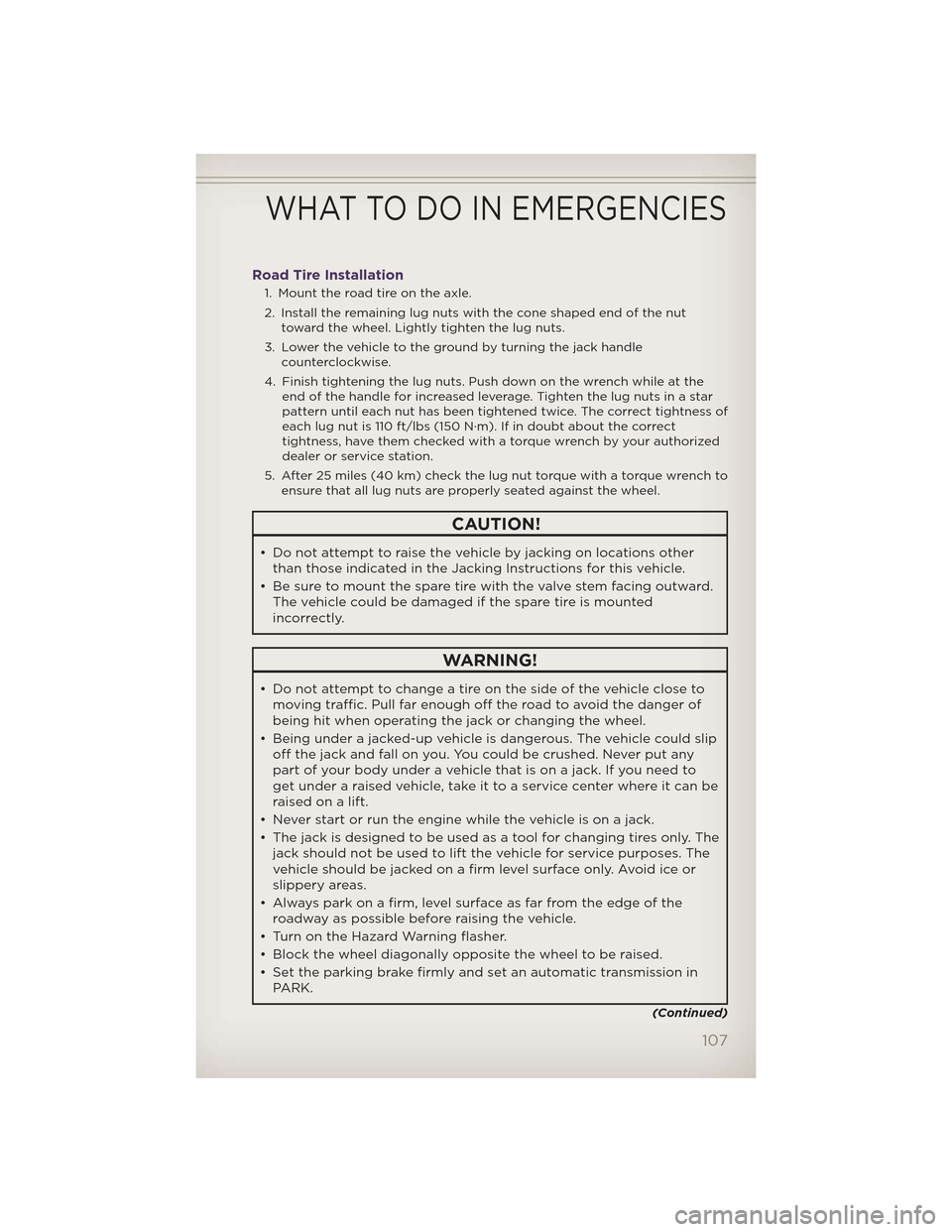
Road Tire Installation
1. Mount the road tire on the axle.
2. Install the remaining lug nuts with the cone shaped end of the nuttoward the wheel. Lightly tighten the lug nuts.
3. Lower the vehicle to the ground by turning the jack handle counterclockwise.
4. Finish tightening the lug nuts. Push down on the wrench while at the end of the handle for increased leverage. Tighten the lug nuts in a star
pattern until each nut has been tightened twice. The correct tightness of
each lug nut is 110 ft/lbs (150 N·m). If in doubt about the correct
tightness, have them checked with a torque wrench by your authorized
dealer or service station.
5. After 25 miles (40 km) check the lug nut torque with a torque wrench to ensure that all lug nuts are properly seated against the wheel.
CAUTION!
• Do not attempt to raise the vehicle by jacking on locations otherthan those indicated in the Jacking Instructions for this vehicle.
• Be sure to mount the spare tire with the valve stem facing outward. The vehicle could be damaged if the spare tire is mounted
incorrectly.
WARNING!
• Do not attempt to change a tire on the side of the vehicle close tomoving traffic. Pull far enough off the road to avoid the danger of
being hit when operating the jack or changing the wheel.
• Being under a jacked-up vehicle is dangerous. The vehicle could slip off the jack and fall on you. You could be crushed. Never put any
part of your body under a vehicle that is on a jack. If you need to
get under a raised vehicle, take it to a service center where it can be
raised on a lift.
• Never start or run the engine while the vehicle is on a jack.
• The jack is designed to be used as a tool for changing tires only. The jack should not be used to lift the vehicle for service purposes. The
vehicle should be jacked on a firm level surface only. Avoid ice or
slippery areas.
• Always park on a firm, level surface as far from the edge of the
roadway as possible before raising the vehicle.
• Turn on the Hazard Warning flasher.
• Block the wheel diagonally opposite the wheel to be raised.
• Set the parking brake firmly and set an automatic transmission in PARK.
(Continued)
WHAT TO DO IN EMERGENCIES
107
Page 110 of 148
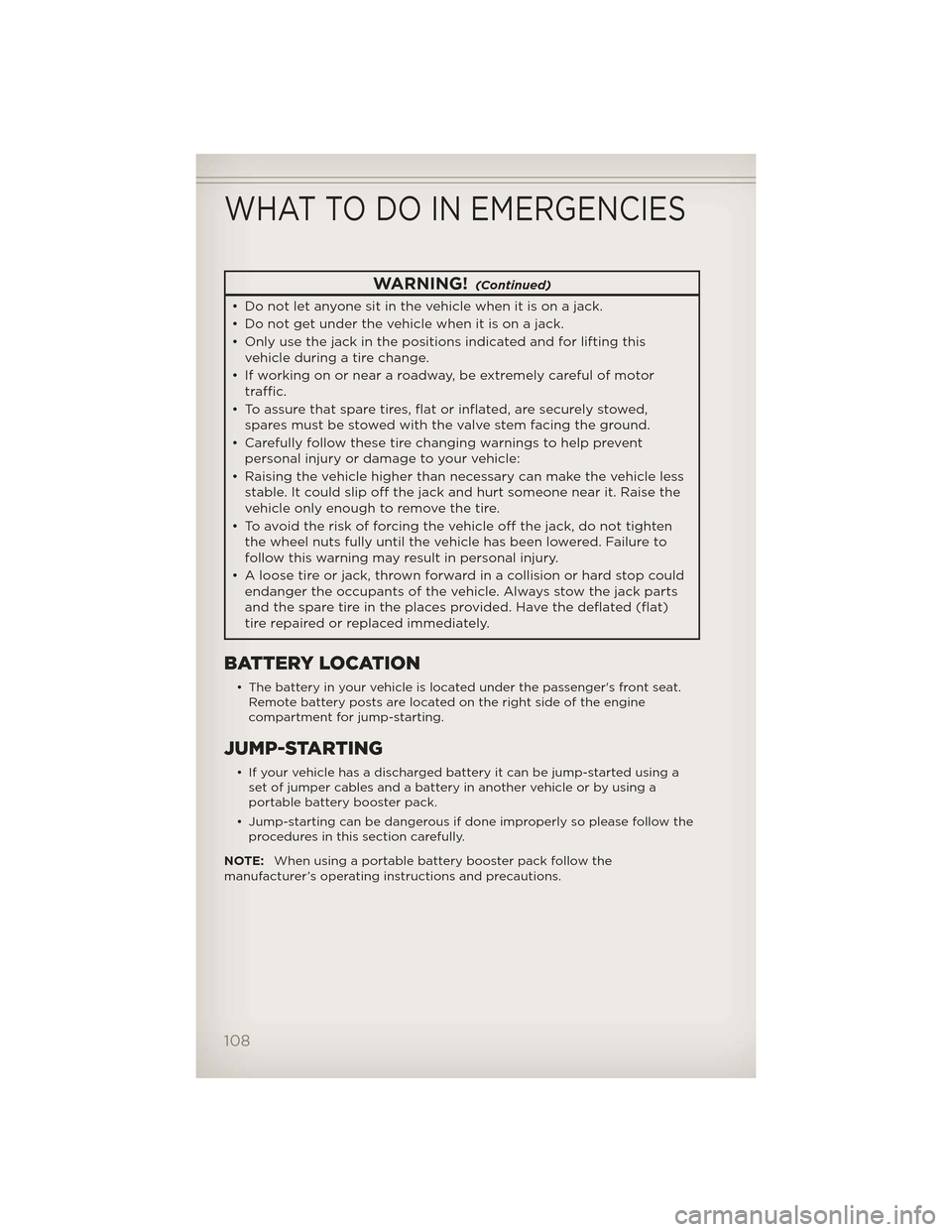
WARNING!(Continued)
• Do not let anyone sit in the vehicle when it is on a jack.
• Do not get under the vehicle when it is on a jack.
• Only use the jack in the positions indicated and for lifting thisvehicle during a tire change.
• If working on or near a roadway, be extremely careful of motor traffic.
• To assure that spare tires, flat or inflated, are securely stowed, spares must be stowed with the valve stem facing the ground.
• Carefully follow these tire changing warnings to help prevent personal injury or damage to your vehicle:
• Raising the vehicle higher than necessary can make the vehicle less stable. It could slip off the jack and hurt someone near it. Raise the
vehicle only enough to remove the tire.
• To avoid the risk of forcing the vehicle off the jack, do not tighten the wheel nuts fully until the vehicle has been lowered. Failure to
follow this warning may result in personal injury.
• A loose tire or jack, thrown forward in a collision or hard stop could endanger the occupants of the vehicle. Always stow the jack parts
and the spare tire in the places provided. Have the deflated (flat)
tire repaired or replaced immediately.
BATTERY LOCATION
• The battery in your vehicle is located under the passenger's front seat. Remote battery posts are located on the right side of the engine
compartment for jump-starting.
JUMP-STARTING
• If your vehicle has a discharged battery it can be jump-started using aset of jumper cables and a battery in another vehicle or by using a
portable battery booster pack.
• Jump-starting can be dangerous if done improperly so please follow the procedures in this section carefully.
NOTE: When using a portable battery booster pack follow the
manufacturer’s operating instructions and precautions.
WHAT TO DO IN EMERGENCIES
108
Page 111 of 148

Preparations for Jump-Start
• The battery in your vehicle islocated under the passengers
front seat. There are remote
locations under the hood to assist
in jump starting.
• Set the parking brake, shift the automatic transmission into PARK
and turn the ignition to LOCK.
• Turn off the heater, radio, and all unnecessary electrical accessories.
• Remove the protective cover over the remote positive (+) battery
post. Pull upward on the cover to
remove it.
• If using another vehicle to jump-start the battery, park the vehicle within the jumper cables reach, set the parking brake and make sure the
ignition is OFF.
Jump-Starting Procedure
• Connect the positive (+)end of the jumper cable to the remote positive
(+) post of the discharged vehicle.
• Connect the opposite end of the positive (+)jumper cable to the positive
(+) post of the booster battery.
• Connect the negative end (-)of the jumper cable to the negative (-)post
of the booster battery.
• Connect the opposite end of the negative (-)jumper cable to the remote
negative (-)post of the vehicle with the discharged battery.
• Start the engine in the vehicle that has the booster battery, let the engine idle a few minutes, and then start the engine in the vehicle with the
discharged battery.
Once the engine is started, remove the jumper cables in the reverse
sequence:
• Disconnect the negative (-)jumper cable from the remote negative (-)
post of the vehicle with the discharged battery.
• Disconnect the negative end (-)of the jumper cable from the negative
(-) post of the booster battery.
• Disconnect the opposite end of the positive (+)jumper cable from the
positive (+)post of the booster battery.
• Disconnect the positive (+)end of the jumper cable from the remote
positive (+)post of the discharged vehicle.
• Reinstall the protective cover over the remote positive (+)battery post
of the discharged vehicle.
WHAT TO DO IN EMERGENCIES
109
Page 112 of 148
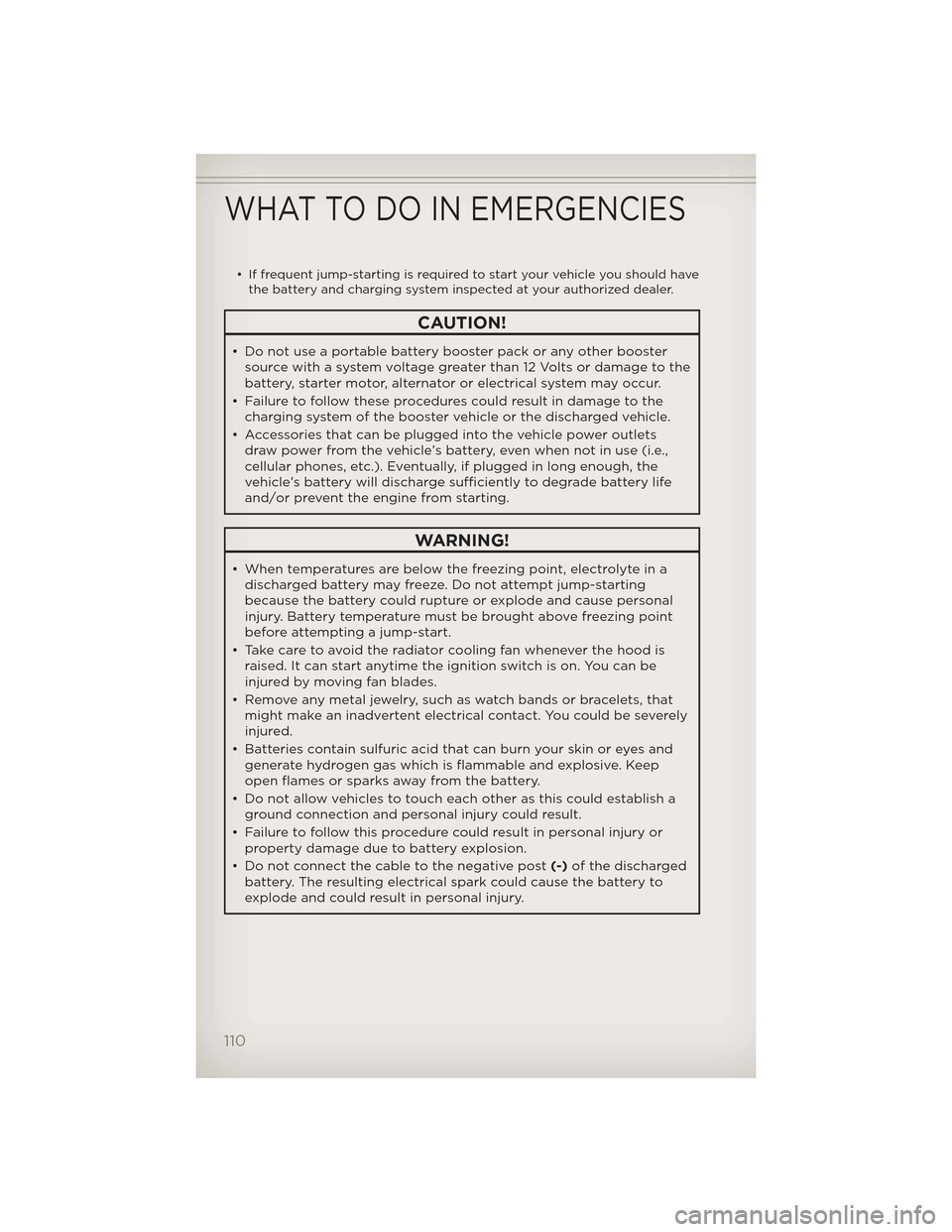
• If frequent jump-starting is required to start your vehicle you should havethe battery and charging system inspected at your authorized dealer.
CAUTION!
• Do not use a portable battery booster pack or any other boostersource with a system voltage greater than 12 Volts or damage to the
battery, starter motor, alternator or electrical system may occur.
• Failure to follow these procedures could result in damage to the charging system of the booster vehicle or the discharged vehicle.
• Accessories that can be plugged into the vehicle power outlets draw power from the vehicle’s battery, even when not in use (i.e.,
cellular phones, etc.). Eventually, if plugged in long enough, the
vehicle’s battery will discharge sufficiently to degrade battery life
and/or prevent the engine from starting.
WARNING!
• When temperatures are below the freezing point, electrolyte in adischarged battery may freeze. Do not attempt jump-starting
because the battery could rupture or explode and cause personal
injury. Battery temperature must be brought above freezing point
before attempting a jump-start.
• Take care to avoid the radiator cooling fan whenever the hood is raised. It can start anytime the ignition switch is on. You can be
injured by moving fan blades.
• Remove any metal jewelry, such as watch bands or bracelets, that might make an inadvertent electrical contact. You could be severely
injured.
• Batteries contain sulfuric acid that can burn your skin or eyes and generate hydrogen gas which is flammable and explosive. Keep
open flames or sparks away from the battery.
• Do not allow vehicles to touch each other as this could establish a ground connection and personal injury could result.
• Failure to follow this procedure could result in personal injury or property damage due to battery explosion.
• Do not connect the cable to the negative post (-)of the discharged
battery. The resulting electrical spark could cause the battery to
explode and could result in personal injury.
WHAT TO DO IN EMERGENCIES
110
Page 113 of 148
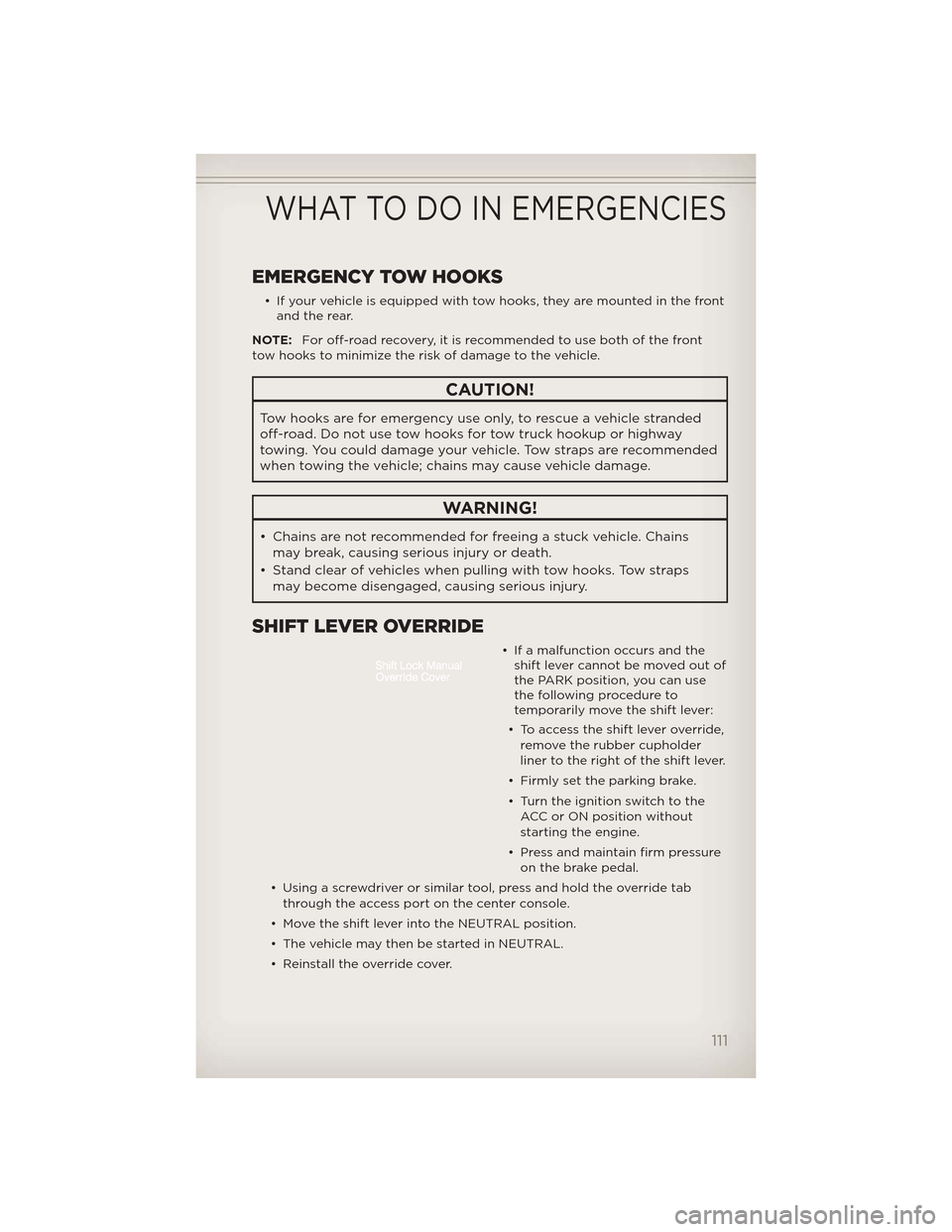
EMERGENCY TOW HOOKS
• If your vehicle is equipped with tow hooks, they are mounted in the frontand the rear.
NOTE: For off-road recovery, it is recommended to use both of the front
tow hooks to minimize the risk of damage to the vehicle.
CAUTION!
Tow hooks are for emergency use only, to rescue a vehicle stranded
off-road. Do not use tow hooks for tow truck hookup or highway
towing. You could damage your vehicle. Tow straps are recommended
when towing the vehicle; chains may cause vehicle damage.
WARNING!
• Chains are not recommended for freeing a stuck vehicle. Chains may break, causing serious injury or death.
• Stand clear of vehicles when pulling with tow hooks. Tow straps may become disengaged, causing serious injury.
SHIFT LEVER OVERRIDE
• If a malfunction occurs and theshift lever cannot be moved out of
the PARK position, you can use
the following procedure to
temporarily move the shift lever:
• To access the shift lever override, remove the rubber cupholder
liner to the right of the shift lever.
• Firmly set the parking brake.
• Turn the ignition switch to the ACC or ON position without
starting the engine.
• Press and maintain firm pressure on the brake pedal.
• Using a screwdriver or similar tool, press and hold the override tab through the access port on the center console.
• Move the shift lever into the NEUTRAL position.
• The vehicle may then be started in NEUTRAL.
• Reinstall the override cover.
WHAT TO DO IN EMERGENCIES
111
Page 118 of 148
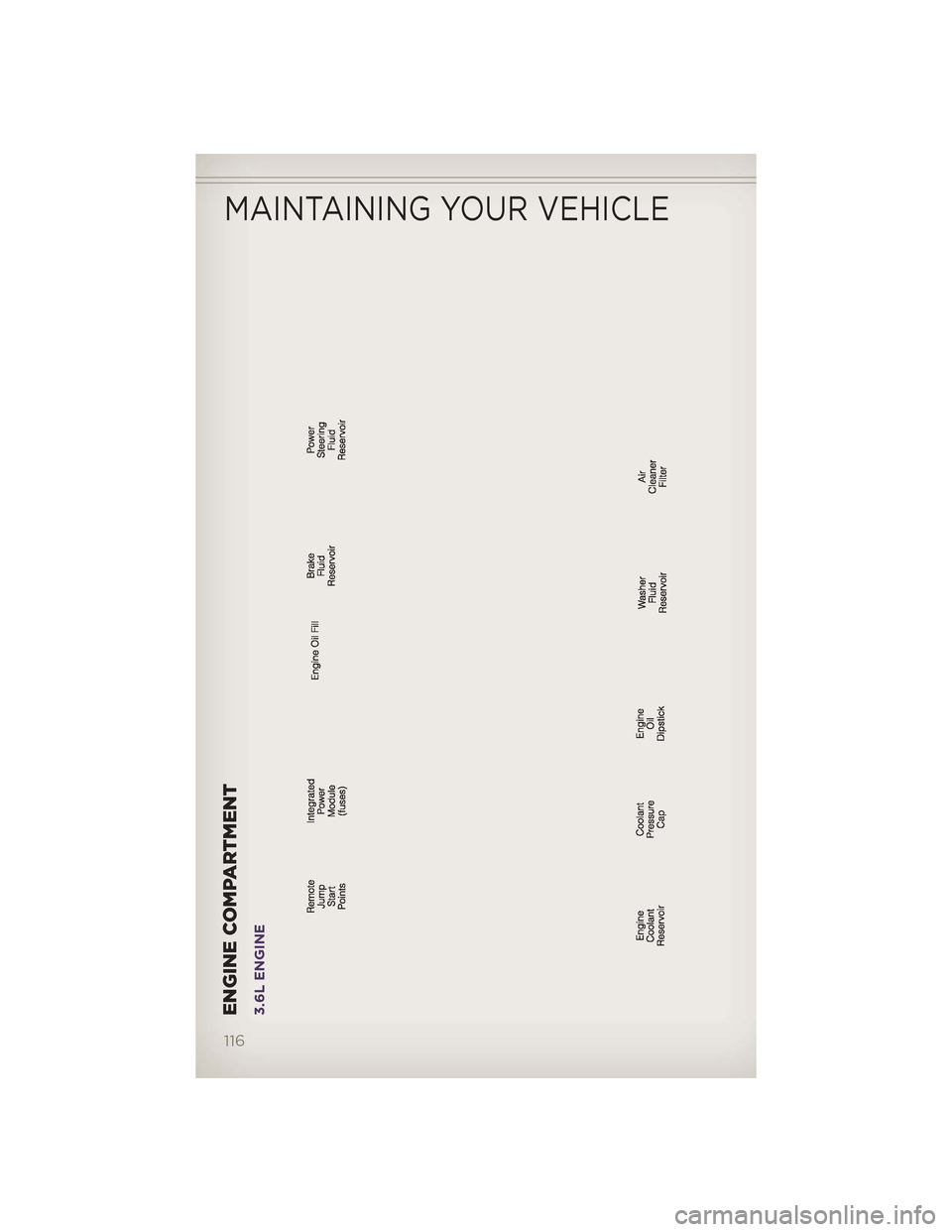
ENGINE COMPARTMENT3.6L ENGINE
MAINTAINING YOUR VEHICLE
116
Page 119 of 148
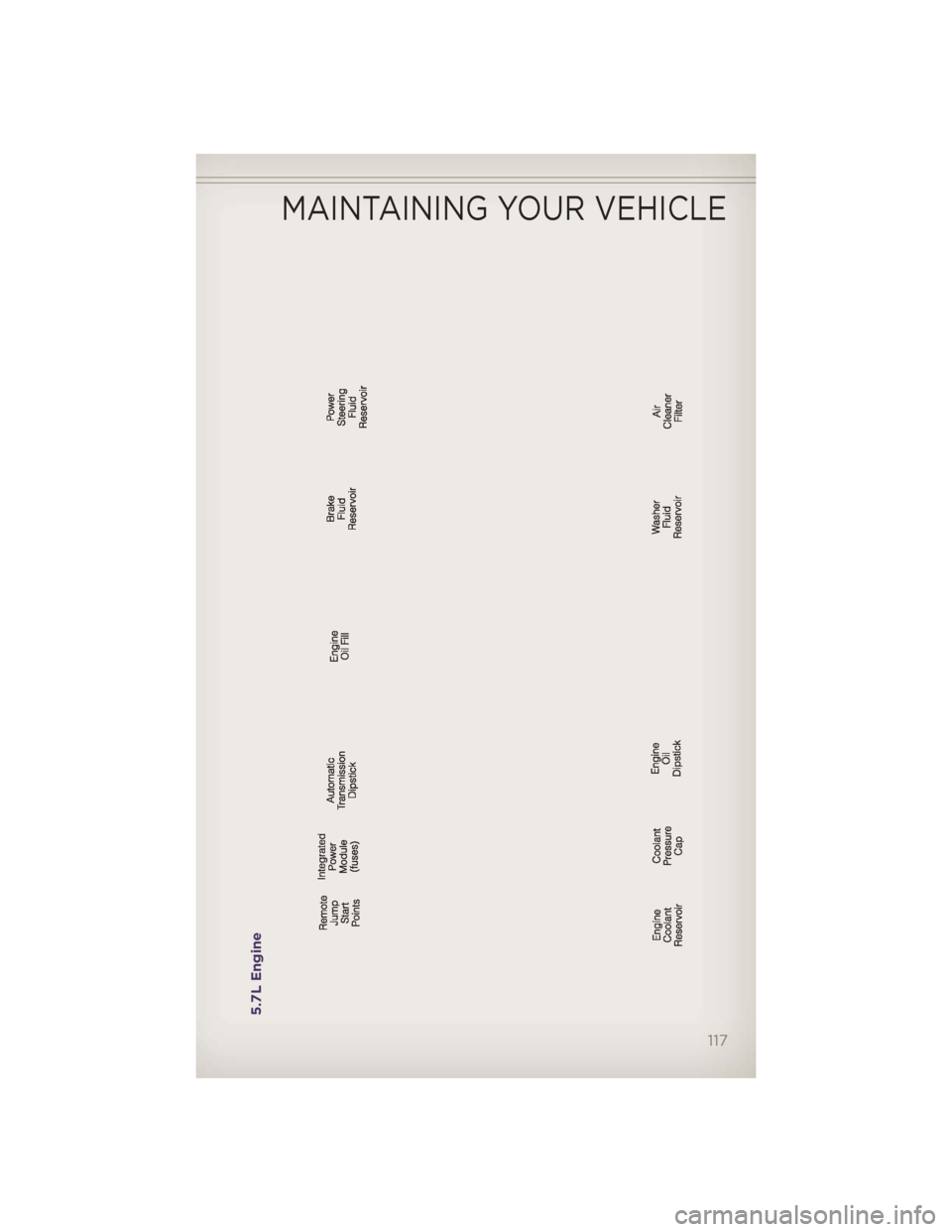
5.7L Engine
MAINTAINING YOUR VEHICLE
117
Page 120 of 148
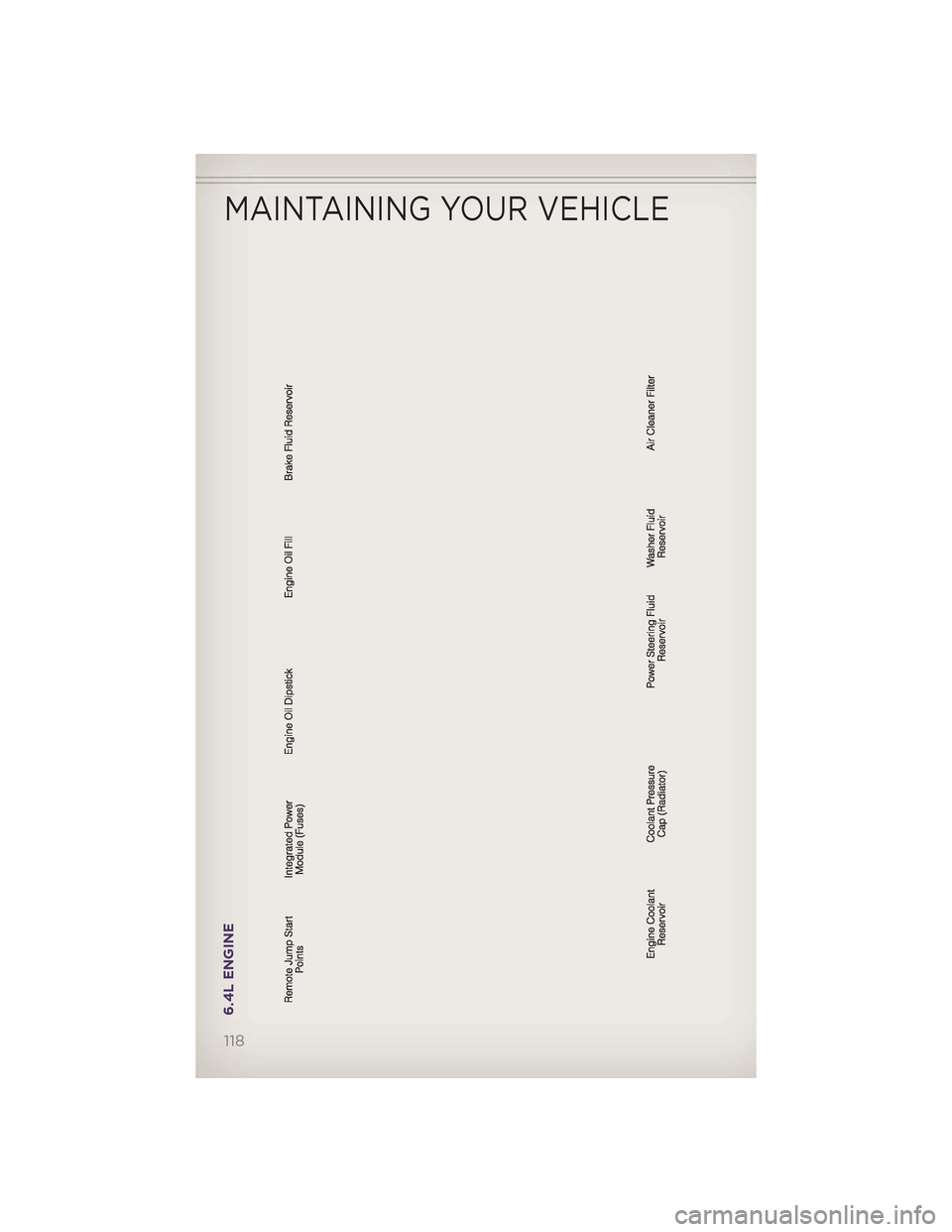
6.4L ENGINE
MAINTAINING YOUR VEHICLE
118
Page 121 of 148
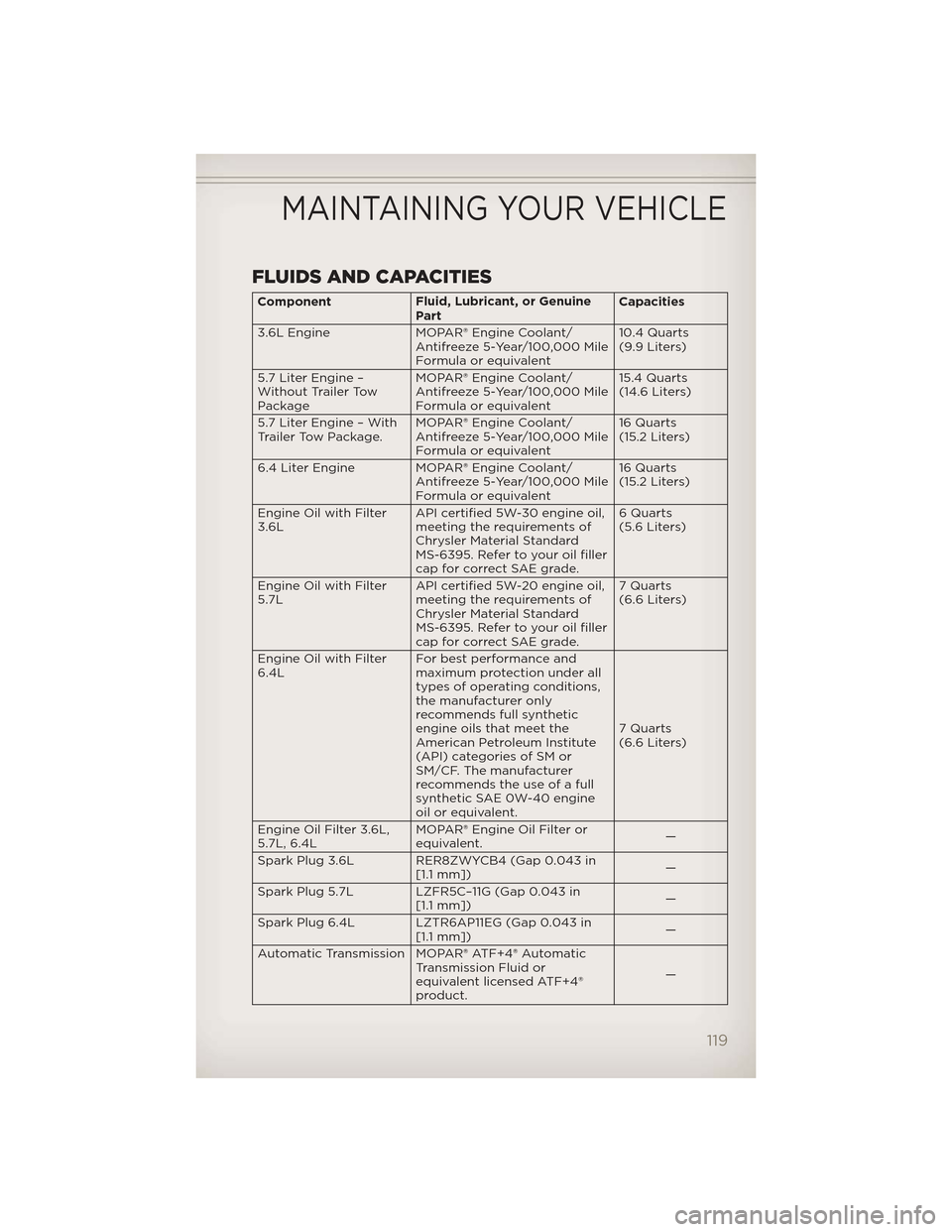
FLUIDS AND CAPACITIES
ComponentFluid, Lubricant, or Genuine
Part Capacities
3.6L Engine MOPAR® Engine Coolant/ Antifreeze 5-Year/100,000 Mile
Formula or equivalent 10.4 Quarts
(9.9 Liters)
5.7 Liter Engine –
Without Trailer Tow
Package MOPAR® Engine Coolant/
Antifreeze 5-Year/100,000 Mile
Formula or equivalent 15.4 Quarts
(14.6 Liters)
5.7 Liter Engine – With
Trailer Tow Package. MOPAR® Engine Coolant/
Antifreeze 5-Year/100,000 Mile
Formula or equivalent 16 Quarts
(15.2 Liters)
6.4 Liter Engine MOPAR® Engine Coolant/ Antifreeze 5-Year/100,000 Mile
Formula or equivalent 16 Quarts
(15.2 Liters)
Engine Oil with Filter
3.6L API certified 5W-30 engine oil,
meeting the requirements of
Chrysler Material Standard
MS-6395. Refer to your oil filler
cap for correct SAE grade. 6 Quarts
(5.6 Liters)
Engine Oil with Filter
5.7L API certified 5W-20 engine oil,
meeting the requirements of
Chrysler Material Standard
MS-6395. Refer to your oil filler
cap for correct SAE grade. 7 Quarts
(6.6 Liters)
Engine Oil with Filter
6.4L For best performance and
maximum protection under all
types of operating conditions,
the manufacturer only
recommends full synthetic
engine oils that meet the
American Petroleum Institute
(API) categories of SM or
SM/CF. The manufacturer
recommends the use of a full
synthetic SAE 0W-40 engine
oil or equivalent. 7 Quarts
(6.6 Liters)
Engine Oil Filter 3.6L,
5.7L, 6.4L MOPAR® Engine Oil Filter or
equivalent.
—
Spark Plug 3.6L RER8ZWYCB4 (Gap 0.043 in [1.1 mm]) —
Spark Plug 5.7L LZFR5C–11G (Gap 0.043 in [1.1 mm]) —
Spark Plug 6.4L LZTR6AP11EG (Gap 0.043 in [1.1 mm]) —
Automatic Transmission MOPAR® ATF+4® Automatic Transmission Fluid or
equivalent licensed ATF+4®
product. —
MAINTAINING YOUR VEHICLE
119
Page 122 of 148

ComponentFluid, Lubricant, or Genuine
Part Capacities
Transfer Case – 3.6L
Engine Shell Automatic Transmission
Fluid 3353 or equivalent.
—
Transfer Case – 5.7L
Engine MOPAR® ATF+4® Automatic
Transmission Fluid or
equivalent licensed ATF+4®
product. —
Transfer Case – 6.4L
Engine MOPAR® NV146 Transfer Case
Fluid or equivalent.
—
Axle Differential
(Front/Rear) We recommend you use
MOPAR® GL-5 Synthetic Axle
Lubricant SAE 75W-85. —
Axle Differential (Rear)
5.7L Engine With
Electronic Limited-Slip
Differential (ELSD) We recommend you use
MOPAR® GL-5 Synthetic Axle
Lubricant SAE 75W-85 with
friction modifier additive.
—
Axle Differential (Rear)
5.7L Engine Without
Electronic Limited-Slip
Differential (ELSD) We recommend you use
MOPAR® GL-5 Synthetic Axle
Lubricant SAE 75W-85.
—
Brake Master Cylinder MOPAR® DOT 3 and SAE J1703 should be used or equivalent. If
DOT 3 is not available, then
DOT 4 is acceptable. Use only
recommended brake fluids. —
Power Steering
Reservoir – 3.6L Engine MOPAR® Hydraulic Fluid or
equivalent meeting MS-11655,
such as Fuchs EG ZH 3044 or
Pentosin CHF 11s. —
Power Steering
Reservoir – 5.7L, 6.4L
Engine MOPAR® Power Steering Fluid
+4, MOPAR® ATF+4® Automatic
Transmission Fluid or
equivalent licensed ATF+4®
product.
Fuel Selection 3.6L,
5.7L 87 Octane acceptable.
89 Octane recommended for
5.7L. 24.6 Gallons
(93 Liters)
(Approximate)
Fuel Selection 6.4L Premium Unleaded 91 Octane Only or Higher.
E-85 Flexible Fuel – 3.6L Engine Only
CAUTION!
Only vehicles with the E-85 fuel filler door label or a yellow gas cap
can operate on E-85.
• Refer to your Owner's Manual on the DVD for further details.
MAINTAINING YOUR VEHICLE
120